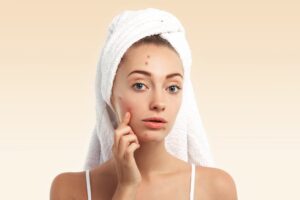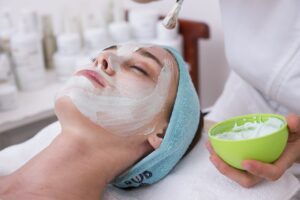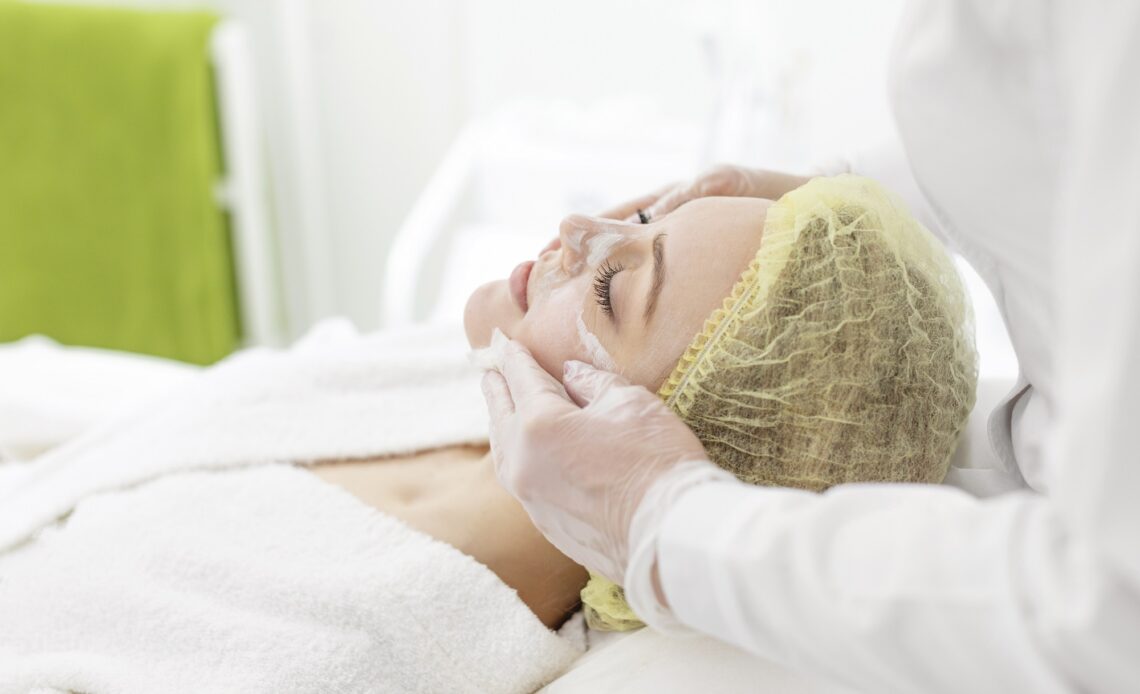Introduction
Acne scars can be a frustrating reminder of past breakouts, affecting not only our skin’s appearance but also our self-confidence. Fortunately, chemical peels have emerged as a popular and effective solution for reducing the visibility of acne scars. In this comprehensive overview, we will delve into the world of chemical peels, how they work, and their role in addressing acne scars.
Understanding Acne Scars
Before we explore chemical peels, it’s essential to understand the different types of acne scars. Acne scars generally fall into two main categories: atrophic (indented) and hypertrophic (raised) scars. Here’s an explanation of the two main categories of acne scars and their subtypes:

Atrophic (Indented) Scars:
Atrophic scars result from a loss of tissue, creating depressions or indentations in the skin. There are three main subtypes of atrophic scars:
- Icepick Scars: These are narrow, deep scars that resemble small puncture marks on the skin. They often extend into the dermis, the deeper layer of skin.
- Boxcar Scars: Boxcar scars have well-defined edges and are wider than icepick scars. They create a box-like appearance with sharp vertical edges. These scars can be shallow or deep.
- Rolling Scars: Rolling scars are characterized by wave-like undulations on the skin. They give the skin a rolling or wave-like texture and are usually caused by damage beneath the skin’s surface.
Hypertrophic (Raised) Scars:
These kind of scars result from an overproduction of collagen during the healing process, leading to raised, thickened areas of skin. Hypertrophic scars elevate rather than depress, unlike atrophic scars.
Understanding the specific type of acne scars a person has is important because different treatments may be more effective for certain types. One can use chemical peels as a treatment option to improve the appearance of acne scars. They involve applying a chemical solution to the skin, which causes the top layers to peel off, revealing smoother skin underneath. The choice of chemical peel and the concentration of the solution depend on the type and severity of the acne scars.
How Chemical Peels Work
Chemical peels, as dermatological procedures, utilize various chemical solutions to effectively exfoliate the top layers of the skin. This controlled exfoliation encourages the growth of new, healthier skin cells and helps improve skin texture and appearance. Chemical peels can be tailored to address specific skin issues, including acne scars. Let’s delve deeper into how chemical peels work:
1. Exfoliation of the Skin:
Chemical peels work by applying a chemical solution to the skin’s surface. The type and strength of the solution used can vary based on the specific needs of the individual and the skin condition being treated. These solutions often contain acids, such as alpha hydroxy acids (AHAs), beta hydroxy acids (BHAs), or trichloroacetic acid (TCA).

- Alpha Hydroxy Acids (AHAs): These include glycolic acid and lactic acid, and they work on the skin’s surface to exfoliate dead skin cells.
- Beta Hydroxy Acids (BHAs): Salicylic acid is a common BHA used in chemical peels. BHAs penetrate deeper into the skin, making them effective for treating acne-related issues.
- Trichloroacetic Acid (TCA): TCA peels are stronger and penetrate deeper than AHAs, making them suitable for addressing more significant skin concerns.
2. Removal of Dead Skin Cells:
The chemical solution causes the top layers of the skin to peel off. This process removes dead skin cells, unclogs pores, and stimulates the regeneration of new skin cells.
3. Stimulation of Collagen Production:
Chemical peels can stimulate the production of collagen, a protein that provides structural support to the skin. This is particularly beneficial for addressing the appearance of fine lines, wrinkles, and certain types of scars, including acne scars.
4. Improved Skin Texture and Tone:
As the old, damaged skin is exfoliated, the new skin that emerges is often smoother, more even in tone, and has a healthier appearance. This can contribute to an overall improvement in skin texture.
5. Tailored Treatment for Acne Scars:
Chemical peels can be customized to target specific skin concerns, including various types of acne scars. The depth and strength of the peel can be adjusted based on the severity of the scarring. Deeper peels may be required for more profound scars, while milder peels can be effective for superficial scars.
6. Recovery and Results:
The recovery time after a chemical peel depends on the depth of the peel. Superficial peels may result in minimal downtime, while deeper peels may require more recovery time. After the peeling process is complete, individuals often notice improved skin texture, reduced pigmentation, and a more youthful appearance.
Trained professionals, such as dermatologists or licensed skincare practitioners, should perform chemical peels to ensure safety and optimal results. Additionally, proper post-peel care, including sun protection, is essential to protect the newly exposed skin and maintain the benefits of the treatment.
Types of Chemical Peels for Acne Scars
Superficial (Light) Peels:
- Acids Used: Typically, alpha hydroxy acids (AHAs) like glycolic acid or beta hydroxy acids (BHAs) such as salicylic acid.
- Depth of Penetration: Superficial peels target the outermost layer of the skin (epidermis).
- Effectiveness: Ideal for mild acne scars, fine lines, and overall skin texture improvement.
- Downtime: Little to no downtime, making them a popular choice for those with a busy lifestyle.
- Frequency: May require multiple sessions for optimal results.
Medium Peels:
- Acids Used: Trichloroacetic acid (TCA) is commonly employed for medium-depth peels.
- Depth of Penetration: Penetrates into the middle layers of the skin (dermis).
- Effectiveness: Suitable for more pronounced acne scars, pigmentation irregularities, and moderate wrinkles.
- Downtime: Longer recovery compared to superficial peels, with potential for redness, swelling, and peeling.
- Frequency: Usually performed as a one-time treatment, but multiple sessions may be recommended for severe concerns.
Deep Peels:
- Acids Used: Phenol is the primary acid used for deep peels.
- Depth of Penetration: Penetrates into the deeper layers of the dermis.
- Effectiveness: Reserved for severe acne scarring, deep wrinkles, and significant skin damage.
- Downtime: Substantial recovery time, often involving several weeks of redness, swelling, and peeling.
- Frequency: Typically a one-time treatment due to the intensity and long recovery period.
Emphasizing the importance of tailoring the choice of a chemical peel to the individual’s specific skin concerns, the severity of acne scars, and other factors, such as skin type and medical history, is essential. The expertise of a dermatologist or skincare professional is crucial; it plays a key role in determining the most suitable type and strength of chemical peel for optimal results while minimizing risks and side effects. Additionally, post-peel care, including sun protection and skincare routines, plays a vital role in maintaining and enhancing the benefits of the chemical peel.
The Procedure
During a chemical peel for acne scars, a dermatologist will cleanse your skin and then apply the chosen chemical solution. You may feel a mild stinging or burning sensation, which subsides quickly. The chemical peel is then neutralized, and the outer layer of skin will gradually peel off in the days following the procedure. Let’s break down the process in more detail:
1. Consultation and Skin Assessment:
Before the procedure, you’ll typically have a consultation with a dermatologist or skincare professional. They will assess your skin, discuss your medical history, and determine the type and strength of the chemical peel that best suits your skin concerns.
2. Skin Cleansing:
The treatment area is thoroughly cleansed to remove any makeup, oils, or debris from the skin. This ensures that the chemical solution can penetrate evenly.
3. Application of Chemical Solution:
The chosen chemical solution is then applied to the skin. The type and concentration of the solution depend on the depth of the peel and the specific skin concerns being addressed. The application may be done using a brush or cotton applicator.
4. Sensation During Application:
As the chemical solution is applied, you may experience a mild stinging or burning sensation. This is a normal response to the acids in the peel and is usually temporary. The intensity of the sensation can vary based on the depth of the peel and individual pain tolerance.
5. Duration of Application:
The duration the chemical solution remains on the skin depends on the type of peel being performed. Superficial peels typically require a shorter application time compared to medium or deep peels.
6. Neutralization:
After the desired time, the dermatologist will neutralize the chemical solution. This halts the peeling process and prevents further penetration of the acids. Neutralization is a crucial step to ensure the safety and effectiveness of the procedure.
7. Post-Peel Care:
Depending on the depth of the peel, you’ll be given specific post-peel care instructions. This may include the use of gentle cleansers, moisturizers, and sunscreen. Sun protection is particularly crucial after a chemical peel to protect the newly exposed skin from UV damage.
8. Peeling Process:
In the days following the procedure, the outer layer of skin will start to peel. This process may vary in duration and intensity depending on the depth of the peel. It’s essential to avoid picking or scratching at the peeling skin to prevent complications.
9. Follow-Up Appointments:
The severity of the acne scars and the treatment plan may recommend multiple sessions. The dermatologist uses follow-up appointments to assess progress and determine if additional treatments are needed.
It’s crucial to communicate openly with your dermatologist throughout the process, informing them of any unusual reactions or concerns. Additionally, adhering to post-peel care instructions and attending follow-up appointments will contribute to the overall success of the treatment.
What to Expect

- Post-Peel Recovery: Your skin will be more sensitive and may appear red and flaky for several days to a few weeks, depending on the type of peel.
- Results: Improvement in the appearance of acne scars can become noticeable after a few sessions, with more significant results achieved over time.
- Sun Protection: Protecting your skin from UV exposure is crucial during the healing process and afterward to maintain results.
Is It Effective?
Health professionals consider chemical peels effective for reducing the appearance of acne scars. The extent of improvement depends on factors such as the type of peel, scar severity, and the individual’s skin type. Achieving optimal results may require multiple sessions.
Conclusion
Chemical peels for acne scars offer a comprehensive solution to address the physical and emotional impact of acne scarring. While they are generally safe and effective, it’s crucial to consult a dermatologist to determine the most suitable type of peel for your specific needs. With the right approach and patience, chemical peels can help you regain smoother, more radiant skin, restoring your confidence and self-esteem.


